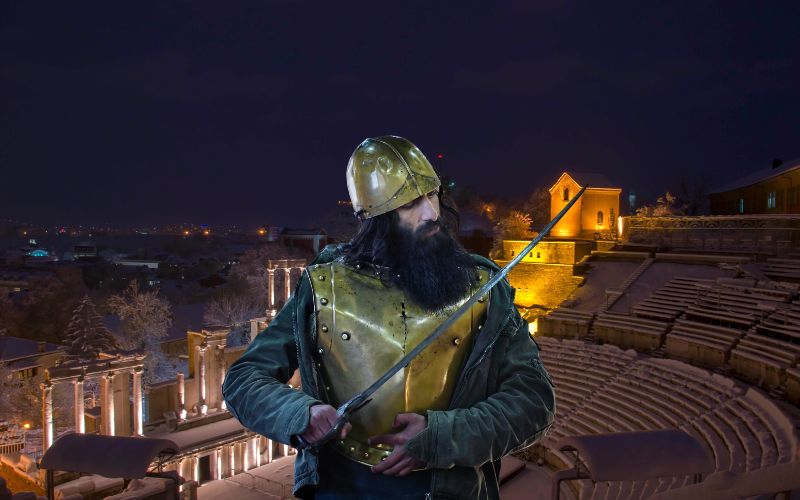Table of Contents
- Introduction
- Overview of Historical Armors, Leather Suits, and Weapons
- Relevance and Importance Today
- Historical Development
- Origins of Armors and Weapons
- Evolution Through the Ages
- Types of Historical Armors
- Plate Armors
- Chainmail Armors
- Leather Armors
- Types of Leather Suits
- Leather Brigandines
- Studded Leather Armors
- Leather Jerkin
- Types of Historical Weapons
- Axes
- Hammers
- Swords
- Craftsmanship and Materials
- Traditional Crafting Techniques
- Modern Manufacturing Methods
- Materials Used in Armors and Weapons
- Applications and Uses
- Historical Reenactments
- LARP and Cosplay
- Film and Theatre
- Functional Armor and Weapons for Combat Sports
- Benefits of Historical Armors, Leather Suits, and Weapons
- Protection and Durability
- Historical Accuracy and Aesthetic Appeal
- Collectibility and Investment Value
- Challenges and Limitations
- Weight and Comfort Issues
- Maintenance and Care
- Buying Guide
- How to Choose the Right Armor, Leather Suit, or Weapon
- Key Considerations When Purchasing
- Trusted Brands and Manufacturers
- Maintenance and Care
- Cleaning and Storage Tips
- Repairing Damaged Armors and Weapons
- Personal Stories and Case Studies
- Historical Figures and Their Armors and Weapons
- Modern Enthusiasts and Collectors
- Expert Insights
- Quotes and Advice from Historical Armor and Weapon Experts
- The Future of Historical Armor and Weapon Crafting
- FAQs
- Common Questions About Historical Armors, Leather Suits, and Weapons
- Expert Answers and Tips
- Conclusion
- Summary of Key Points
- Call to Action for Further Education
Introduction
Overview of Historical Armors, Leather Suits, and Weapons
Throughout history, armors, leather suits, and weapons have played a crucial role in warfare and personal protection. These items, crafted with meticulous detail and innovative techniques, not only provided essential defense but also showcased the artistry and technological advancements of their time. Today, they are appreciated for their historical significance, craftsmanship, and versatility in various modern applications.
Relevance and Importance Today
In contemporary settings, historical armors, leather suits, and weapons are used in historical reenactments, LARP (Live Action Role-Playing), cosplay, film and theatre productions, and combat sports. Collectors and enthusiasts value these items for their aesthetic appeal, historical authenticity, and the craftsmanship involved in their creation. Understanding their history, types, and uses can enhance one’s appreciation and knowledge of these fascinating artifacts.
Historical Development
Origins of Armors and Weapons
The earliest armors and weapons date back to ancient civilizations, where they were made from materials like leather, bronze, and iron. These items evolved as societies advanced, leading to more sophisticated designs and improved protection.
Evolution Through the Ages
Over the centuries, the design and functionality of armors and weapons evolved to meet the changing demands of warfare. From the bronze armors of ancient Greece to the steel plate armors of medieval Europe, each era brought innovations that enhanced protection and combat effectiveness.
Types of Historical Armors
Plate Armors
Plate armors, made from large metal plates, provided comprehensive protection for the wearer. They were particularly popular during the late medieval and Renaissance periods.
Chainmail Armors
Chainmail armors, consisting of interlinked metal rings, offered a balance between flexibility and protection. They were widely used by various cultures from the ancient to the medieval periods.
Leather Armors
Leather armors were made from hardened leather and often reinforced with metal or bone. They were lighter and more flexible than metal armors, making them a popular choice for light infantry and archers.
Types of Leather Suits
Leather Brigandines
Brigandines are leather garments reinforced with small metal plates riveted to the inside. They provide excellent protection while maintaining flexibility and comfort.
Studded Leather Armors
Studded leather armors feature metal studs or rivets that provide additional protection and durability. They were commonly used by light infantry and cavalry.
Leather Jerkin
A leather jerkin is a sleeveless jacket made from tough leather, often worn over other armor for added protection and mobility.
Types of Historical Weapons
Axes
Axes, with their sharp blades and powerful strikes, were effective weapons in both combat and utility. They come in various forms, including battle axes and throwing axes.
Hammers
War hammers, designed to deliver powerful blows, were particularly effective against armored opponents. They feature a striking head and a pick or spike on the opposite side.
Swords
Swords were versatile weapons used by warriors throughout history. They come in numerous styles, including the longsword, rapier, and katana, each with its unique characteristics.
Craftsmanship and Materials
Traditional Crafting Techniques
Traditional crafting techniques involved hand-forging metal, tanning leather, and intricate decorative work. These labor-intensive processes required great skill and expertise.
Modern Manufacturing Methods
Today, armors and weapons can be produced using modern techniques such as casting and stamping, which allow for greater precision and consistency. However, handmade pieces are still highly valued for their authenticity and craftsmanship.
Materials Used in Armors and Weapons
Historically, armors and weapons were made from materials such as iron, steel, leather, and wood. Modern reproductions may use these materials or alternatives like aluminum and stainless steel, offering similar appearance and durability with less weight.
Applications and Uses
Historical Reenactments
Historical reenactors use period-accurate armors, leather suits, and weapons to authentically recreate battles and events from the past. These items provide not only protection but also an essential visual element that enhances the realism of the reenactments.
LARP and Cosplay
In LARP and cosplay, historical armors, leather suits, and weapons add authenticity and visual appeal to costumes. They help bring characters to life and create an immersive experience for participants.
Film and Theatre
Armors and weapons are frequently used in film and theatre to depict historical or fantasy characters accurately. They contribute to the visual storytelling and help create a believable setting.
Functional Armor and Weapons for Combat Sports
Certain combat sports, such as HEMA (Historical European Martial Arts), utilize historical armors and weapons for protection and training. These items ensure safety while allowing participants to engage in realistic combat scenarios.
Benefits of Historical Armors, Leather Suits, and Weapons
Protection and Durability
Historical armors, leather suits, and weapons provide excellent protection and durability, making them suitable for both display and functional use.
Historical Accuracy and Aesthetic Appeal
Authentic reproductions of historical armors, leather suits, and weapons offer a visual and tactile connection to the past. They are prized for their historical accuracy and intricate designs.
Collectibility and Investment Value
High-quality historical armors, leather suits, and weapons are sought after by collectors and can appreciate in value over time. They are not only a passion for enthusiasts but also a worthwhile investment.
Challenges and Limitations
Weight and Comfort Issues
One of the main drawbacks of historical armors and weapons is their weight, which can be uncomfortable during extended use. Modern reproductions often use lighter materials to address this issue while maintaining historical accuracy.
Maintenance and Care
Proper maintenance is essential to prevent rust and damage. Armors and weapons should be regularly cleaned, oiled, and stored in a dry, cool place to preserve their condition.
Buying Guide
How to Choose the Right Armor, Leather Suit, or Weapon
When selecting historical armors, leather suits, or weapons, consider their intended use, the material, and the craftsmanship. Handmade pieces may be more expensive but offer greater authenticity and durability.
Key Considerations When Purchasing
Look for reputable sellers and manufacturers who provide detailed information about their products. Pay attention to the type of metal used, the historical accuracy of the design, and the overall quality.
Trusted Brands and Manufacturers
Some well-known brands and manufacturers specialize in high-quality historical armors, leather suits, and weapons. Research and reviews can help you identify reliable sources for purchasing.
Maintenance and Care
Cleaning and Storage Tips
Regularly clean your armors, leather suits, and weapons with mild soap and water, and thoroughly dry them to prevent rust. Store them in a dry, cool place, and use silica gel packs to absorb moisture.
Repairing Damaged Armors and Weapons
Repairing armors and weapons involves fixing dents, replacing damaged parts, and restoring any decorative elements. This can often be done by a professional or through DIY methods if you have the necessary skills.
Personal Stories and Case Studies
Historical Figures and Their Armors and Weapons
Historical figures such as Richard the Lionheart and Joan of Arc are known for their iconic armors and weapons, which symbolize their leadership and bravery. These items are often replicated and celebrated for their historical significance.
Modern Enthusiasts and Collectors
Today, many enthusiasts and collectors appreciate historical armors, leather suits, and weapons for their craftsmanship and historical value. Interviews and profiles of these individuals can provide insights into the community and its passion for historical artifacts.
Expert Insights
Quotes and Advice from Historical Armor and Weapon Experts
Experts in historical armor and weapons offer valuable advice on choosing, maintaining, and appreciating these items. Their insights can help both beginners and experienced enthusiasts.
The Future of Historical Armor and Weapon Crafting
Advancements in materials and manufacturing techniques continue to shape the future of historical armor and weapon crafting. Experts predict new innovations that will make these items more accessible and versatile.
FAQs
Common Questions About Historical Armors, Leather Suits, and Weapons
- What is a historical armor?
Historical armor is protective clothing worn by warriors in various periods and cultures, known for its functionality and craftsmanship. - How do I maintain historical armors and weapons?
Regular cleaning, drying, and proper storage are essential to prevent rust and damage. - Are historical armors and weapons still used today?
While not used in modern combat, historical armors and weapons are popular in reenactments, cosplay, film, theatre, and combat sports.
Expert Answers and Tips
Experts recommend investing in high-quality historical armors, leather suits, and weapons for authenticity and durability. They also suggest learning basic maintenance and repair techniques to keep your items in top condition.
Conclusion
Summary of Key Points
Historical armors, leather suits, and weapons are fascinating artifacts that offer a glimpse into the past. Their craftsmanship, historical significance, and versatility in modern applications make them a valuable addition to any collection.
Explore more about historical armors, leather suits, and weapons by visiting reputable sources and engaging with the community of enthusiasts. Whether for reenactments, cosplay, or personal collection, these items provide a unique and enriching connection to history.

